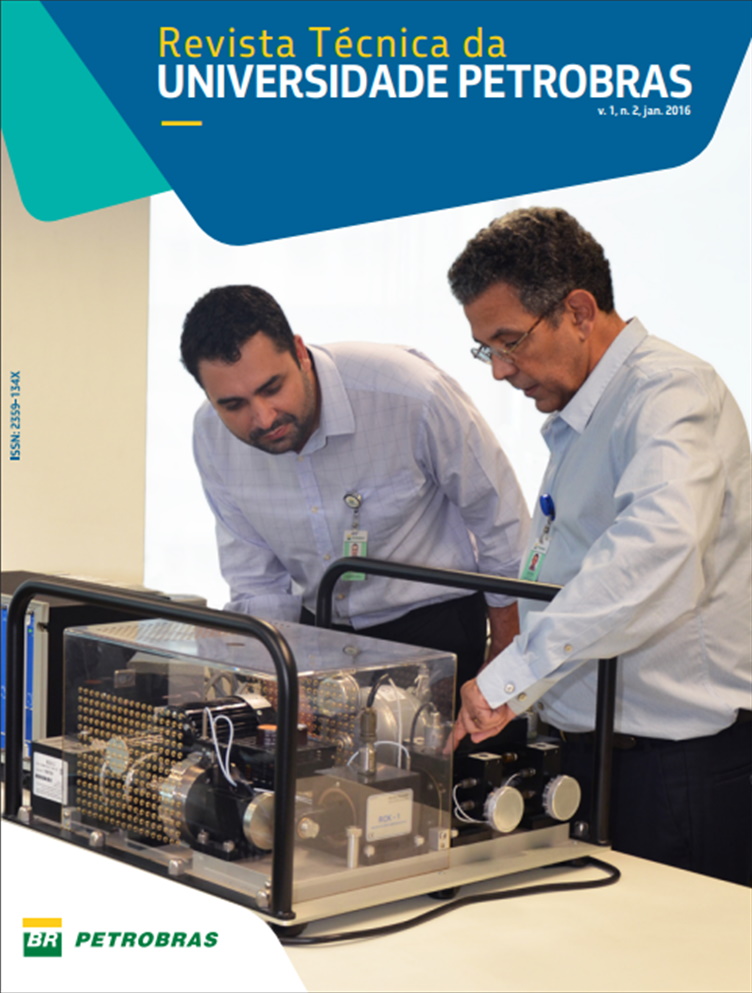Modeling oscillatory behavior of ESP wells under two-phase flow conditions
Palavras-chave:
Electrical Submersible Pump, Two-Phase Flow, Oscillatory Behavior, Transient SimulationResumo
The effect of free gas on the Electrical Submersible Pump (ESP) performance is well known. At a constant rotational speed and constant liquid flowrate, small amount of gas causes a mild head reduction when compared to the single phase liquid head. However, at higher gas rates, a drastic reduction in the head is observed. This critical condition, known as surging point, is a combination of liquid and gas flow rates that cause a maximum in the head performance curve. The first derivative of the head with respect to the liquid flow rate change sign as the liquid flow rate crosses the surging point. In several works on ESP two-phase flow performance, production conditions to the left of the surging region are described or reported as unstable operational conditions. This paper reviews basic concepts on stability of dynamical systems and shows through simulation that ESP oscillatory behavior may result from two-phase flow conditions. A specific drift flux computation code was developed to simulate the dynamic behavior of ESP wells producing without packer.
Referências
LOGAN, J. D. Applied mathematics. 3th ed. New Jersey: Wiley-Interscience, 2006. ISBN: 9780471746621.
WIENS, E.G. Two dimensional flows and phase diagrams. Disponível em: www.egwald.ca/nonlineardynamics/twodimensionaldynamics.php. Acesso em: 20 dez. 2009.
STROGATZ, S. H. Nonlinear dynamics and chaos: with applications to physics, biology, chemistry, and engineering. 1st ed. Boulder, Colorado: Westview Press, 2001.
BOURE, J. A.; BERGLES, A. E.; TONG, L. S. Review of two-phase flow instabilities. Nuclear Engineering and Design, [S.l], v. 25, p. 165-192, 1973.
LAHEY JR., R. T.; PODOWSKI, M. Z. On the analysis of various instabilities in two-phase flows. In: HEWITT, G. F.; DELHAYE,J. M.; ZUBER, N. Multiphase science and technology. Hemisphere, Washington, DC: Hemisphere Publishing Corp., v. 4, p. 183- 370,1989.
HU, B.; GOLAN, M. Gas-lift instability resulted production loss and its remedy by feedback control: dynamical simulation results. In: SPE INTERNATIONAL IMPROVED OIL RECOVERY CONFERENCE IN ASIA PACIFIC, Kuala Lumpur, 2003. SPE 84917.
VIEIRA, R.A.M. Flow dynamics in oil wells. 2011. 305 l. Thesis (Ph.D.) - University of Tulsa. Tulsa, 2011.
ZUBER, N.; FINDLAY, J. A. Average volumetric concentration in two-phase flow systems. Journal Heat Transfer, [S.l.], v. 87, n.4, p. 453-468, 1965.
WOLDESEMAYAT, M. A.; GHAJAR, A. J. Comparison of void fraction correlations for different flow patterns in horizontal and upward inclined pipes. International Journal of Multiphase Flow. Oxford, v. 33, n. 4, p. 347-468, Apr. 2007.
ISHII, M.; HIBIKI, T. One-Dimensional Drift-Flux Model for Various Flow Conditions. Paper present in International Topical Meeting on Nuclear Reactor Thermal-Hydraulics, 11th. Avignon, 2005.
PATANKAR, S. V. Numerical heat transfer and fluid flow. Washington: Hemisphere Pub. Corp.; New York: McGraw-Hill, c1980. (Series in computational methods in mechanics and thermal sciences). ISBN: 0-07-048740-5.
SACHDEVA, R. Two-phase flow through chokes. 1984. 83 l. Thesis (M.S.E.) - University of Tulsa. Tulsa, 1984.
ALHANATI, F. J. S. Bottomhole gas separation efficiency in electrical submersible pump installations. 1993. 140 l. Thesis (Ph.D.)- University of Tulsa. Tulsa, 1993.
DURAN, J. Pressure effects on esp stages air-water performance. 2003. 156 l. Thesis (M.S.E.) - University of Tulsa. Tulsa, 2003.
CARVALHO, P. C. G. et al. Multiphase performance of esp stage part II: case study. Tulsa: University of Tulsa, 2009. Technical Report.
DELHAYE, J. M.; GIOT, M.; RIETHMULLER, M. L. Thermohydraulics of two-phase system for industrial design and nuclear engineering. Chemie Ingenieur Technik. Wahington: New York: London, v. 53, n. 12, p. 991, 1981.
COMPLEX SYSTEMS LABS. Disponível em: http://complex.upf.es/~josep/lorenzatt.jpeg. Acesso em: 20 dez. 2009.




